All posts by admin
LG LAUNCHES NEW THERMA V MONOBLOC ‘S’ HEAT PUMP
Story
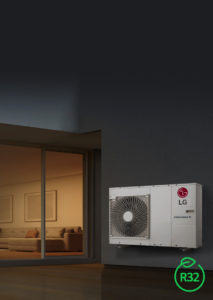 As a New Year comes into view, LG has launched the latest version of its sector leading Therma V Monobloc air to water heat pump – the Therma V R32 Monobloc ‘S’ – into a UK marketplace that is highly responsive to new heat pump technology. The ‘S’ stands for ‘Silence’ and ‘Supreme’ to highlight its reduced noise level and best performance criteria.
As a New Year comes into view, LG has launched the latest version of its sector leading Therma V Monobloc air to water heat pump – the Therma V R32 Monobloc ‘S’ – into a UK marketplace that is highly responsive to new heat pump technology. The ‘S’ stands for ‘Silence’ and ‘Supreme’ to highlight its reduced noise level and best performance criteria.
The announcement recently from Government that it will provide a £5,000 grant from April 2022 to individuals choosing to install a heat pump over existing fossil fuel driven heating systems is the next crucial step towards major uptake of proven heat pump technology in preference to reliance on gas, oil and solid fuel options for domestic heating and hot water provision in the UK. The Future Homes Standard requires serious action and quickly if targets are to be met. Renewables and higher standards of building quality in, for example, recognition of better standards of insulation in UK homes are key to meeting the aims of the FHS. Heat pumps have a major part to play.
The original LG Therma V Monobloc has already seen enormous success in the UK marketplace as heat pump sales in 2021 trebled over sales in the previous year. But this new ‘S’ version is set to make unparalleled sales figures in 2022 as more and more housebuilders and developers, local authorities and social housing providers move to use renewable options in their new build homes and begin the process of replacing older and inefficient gas boilers with an option that future proofs their existing homes in the years ahead.
As with the original Monobloc, this new model combines the indoor and outdoor features in one module. It’s also connected by only water piping, eliminating the need for refrigerant piping, making this heat pump an installer’s dream when it comes to ease of installation.
Hydronic components like the improved plate heat exchanger, the expansion tank, water pump, flow sensor, pressure sensor, air vent valve and safety valve are all built in – inside the outdoor unit – pre-installed and ready to run. And the R32 Monobloc ‘S’ provides excellent heating performance especially at low ambient temperatures whilst lowering its carbon emissions even more with the use of R32.
The innovative design and technology in this new unit sees built in water flow and pressure sensors to monitor the water circuit in real time, advanced water pump control, enhanced second circuit logic, energy monitoring of estimated power consumption via the remote controller, MODBUS connectivity without Gateway if required and advanced control for the domestic hot water recirculation pump.
LG equipment is justly renowned in the industry for its controllers and the new Monobloc ‘S’ is equipped with a new advanced remote controller which supports a number of functions. It comes with a premium design 4.3-inch colour LCD monitor, user friendly interface that uses simple graphic, icon and text controls, easy schedule and installer settings and energy monitoring without meter interface to provide estimated power consumption figures. It is possible to monitor not only the temperature of the water circuit but also the flow rate and the pressure. This information provides installers with more reliable information for installation and maintenance.
 The original version was extremely quiet, but this new ‘S’ version is even quieter and up to 9kW units can be installed at the minimum of 4 metres away, and up to 16kW units – up to 5 metres away from neighbouring houses complying with international noise regulations. And through the use of LG’s ThinQ technology can monitor and control compatible LG products remotely so owners can set the temperature and regulate the use of their Therma V anytime, anywhere. ThinQ technology also works with voice activation with Google Homes.
The original version was extremely quiet, but this new ‘S’ version is even quieter and up to 9kW units can be installed at the minimum of 4 metres away, and up to 16kW units – up to 5 metres away from neighbouring houses complying with international noise regulations. And through the use of LG’s ThinQ technology can monitor and control compatible LG products remotely so owners can set the temperature and regulate the use of their Therma V anytime, anywhere. ThinQ technology also works with voice activation with Google Homes.
Installers will love the new Monobloc ‘S’ – the all-in-one concept and reduced weight of the unit makes for easier and quicker installations. The new version requires lower amounts of refrigerant compared to the existing model – 16.7% less in fact – reducing emissions and lessening its environmental impact still further. The new version features LG’s revolutionary R1 Compressor technology which offers advanced efficiency, reliability and operational range due in part to the enhanced tilting motion of the scroll. It offers enhanced operational range – up to 135Hz, a shaft-through structure and support at both ends of the shaft which ensures higher durability and offers bottom compression and simple structure that offers lower noise and vibration, less weight and superior reliability.
Within the outdoor unit the new version of the LG Monobloc offers a new compressor noise shield, a new Black Fin coated heat exchanger, a new water flow sensor and a new water pressure sensor. There is an option to include a 3kW or 6kW electric back up heater.
The unit comes with a Seasonal Coefficient of Performance of up to 4.67 (Average climate/Low temperature application) and a A+++ rating. The COP rises to 4.9 (Outdoor air 7°C/Leaving water temperature 35°C) and can deliver leaving water temperature of 65°C if required.
Peter Spurway is LG’s National Sales Manager – Heating Projects: “These are exciting times for heat pumps and for LG as we see hugely increased interest and sales of our established Therma V units. This launch of the new Monobloc ‘S’ gives us another massive lift as we can offer the leading monobloc unit on the market. We’re already seeing major interest in the new unit from housebuilders, social housing providers and self-builders – keen to find the best option for renewable heating projects up and down the country. They are seeing the latest advances incorporated into the new unit and with the restriction on the use of fossil fuelled heating in new build properties from 2025 are keen to begin working with the products that they will be using from that time onwards immediately.
“LG Business Solutions UK is a special business unit of LG Electronics and our new build projects team are dedicated to bringing LG’s world-class IOT-enabled smart home innovations to the UK construction industry. The Monobloc S compliments our Split, Hydro Split and High Temp Split units to provide low carbon heating solutions for almost any house type.”
For more information on the new LG Therma V Monobloc ‘S’ head for partner.lge.com/uk, or email LG at uk.aircon@lge.com.
View LG's profile:
Profab Access adds a five star finish to Cardiff’s newest luxury hotel
Story
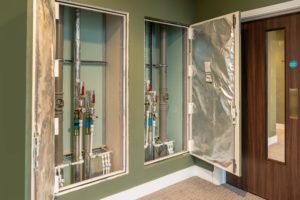 Leading riser door and access panel solution supplier, Profab Access, has proven its first-class credentials once again as part of the recent completion of a major specification at Cardiff’s new 5-star Parkgate hotel.
Leading riser door and access panel solution supplier, Profab Access, has proven its first-class credentials once again as part of the recent completion of a major specification at Cardiff’s new 5-star Parkgate hotel.
Located next to the Welsh Capital’s famous Principality Stadium, the Parkgate hotel has been designed to provide a luxurious experience for rugby fans ahead of the international season, in addition to city dwellers visiting the country all year round. Widely coined as Cardiff’s most lavish new location, the hotel, which will open Autumn 2021, includes 170 guest bedrooms and suites, a signature restaurant and bar, a traditional tea lounge and a rooftop spa overlooking the city skyline.
As part of the prestigious build, a unique collaboration between the Welsh Rugby Union, property developer, Rightacres, and The Celtic Collection, the hotel required an extensive riser door specification, with safety, high performance and aesthetic appeal key considerations.
In total, 310 Profab Access VEGA 1500 Fire Rated Riser Doors were specified for installation by Hazelwood Carpentry throughout every part of the building, including communal areas and the hotel’s vast range of luxury guest rooms and suites.
The VEGA 1500 Series Riser Doors offer the highest standards of fire safety, extensively tested by Efectis in France and Ireland to provide a bi-directionally fire tested product that is available in both single and double door configurations.
This means the riser door sets are fire tested from both sides to 60 minutes, providing the specifiers, contractors and hotel guests residing within the building with confidence the critical fire integrity products offer the highest standard and most up to date evidence for fire safety performance.
The range also features a slimline, neat construction, whilst its proven technology ensures permanent, safe access to mechanical and electrical services housed within the riser core. This provides first class functionality and safety, without compromising the overall interior concept.
The steel riser doors also streamlined the installation process, as the quick release pivot hinge and light weight enabled easy handling, allowing Hazelwood Carpentry to complete the job quickly and optimise overall project efficiencies.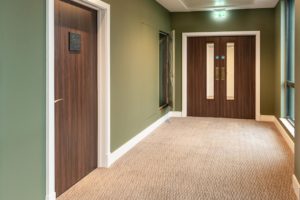
Jamie Homer, Senior Site Supervisor at Hazelwood Carpentry, said: “As a remarkably impressive build designed to bring a new age of modern luxury to Cardiff’s historic setting, it was important we used the most innovative, highest quality products.
“From the start it was clear that there was no contender to Profab Access and its unrivalled capabilities when it comes to high performance, quality fire rated riser doors.
“The Profab Access team recommended the VEGA 1500 Series, which proved a fantastic choice, as it was incredibly easy to install and offers a superb finish, whilst ensuring the highest standard of fire integrity. Plus, being manufactured in the UK ensured quick lead times, which was essential in keeping the project on track for its opening this autumn.
“As usual, the team, who we have worked with many times before, were incredibly helpful and quick to respond to any queries. Needless to say, we look forward to working with Profab Access again on future projects to come.”
In the event of a fire, the VEGA 1500 Series Riser Door sets will maintain the frame and integrity for up to 60 minutes, preventing the spread of fire throughout the property for this period of time.
The riser doors are 31dB acoustic rated, smoke sealed and airtight to Part L, whilst also featuring intumescent smoke seals that enable occupants to safely exit the building. By specifying bi-directionally fire tested VEGA 1500 Series Riser Doors, the development is actively future proofed as the comprehensive testing certification provides a complete and transparent audit trail of due diligence that evidences the products are not only fit for purpose but meet the duty of care required to ensure legal compliance.
Marcus Parnham, Commercial Director at Profab Access, said: “At a time when the hospitality sector has been subject to so much disruption, the Parkgate hotel will play a key role in attracting rugby fans during the peak international season and revitalising the city’s appeal to visitors looking for the ultimate luxury stay.
“The pedigree of our VEGA 1500 Series fit the brief perfectly. Combining functionality and visual appeal, the specification has enabled great performance without comprising aesthetics. More importantly, the specification of our bi-directionally fire tested line ensures the building features the highest levels of riser shaft fire protection currently available on the Irish and UK markets.”
Profab Access’ diverse portfolio of riser doors and access panels are supported by a wide range of BIM Level 2 and CAD files to aid the specification process and streamline the initial design stages.
Manufactured at Profab Access’ Atherstone headquarters in accordance with ISO 9001, the 1500 Series Riser Doors can be specified and installed in a range of configurations to meet each project’s specific measurements and requirements.
For further information on Profab Access and its range of access panels, riser doors and steel doors, call +44(0)1827 719051 or visit https://www.profabaccess.com.

View Access 360's profile:
Strong Kinedo presence at KBB 2022
Story
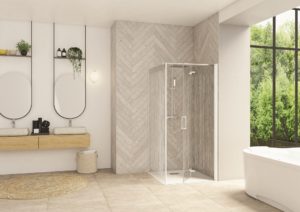 Kinedo is Europe’s leading brand of all-in-one shower cubicles. The comprehensive range is complemented by a portfolio of modern shower enclosures and trays. Two years after the last KBB show at the NEC, which immediately preceded the Covid epidemic, the team at Kinedo has once again booked a space to reinvigorate the interest generated back in 2020 and showcase the brand to a wider audience. The stand, which will showcase a range of bathroom solutions, will be in Hall 20, Stand B82.
Kinedo is Europe’s leading brand of all-in-one shower cubicles. The comprehensive range is complemented by a portfolio of modern shower enclosures and trays. Two years after the last KBB show at the NEC, which immediately preceded the Covid epidemic, the team at Kinedo has once again booked a space to reinvigorate the interest generated back in 2020 and showcase the brand to a wider audience. The stand, which will showcase a range of bathroom solutions, will be in Hall 20, Stand B82.
The Kinedo brand is coming back stronger than ever before with a new sales strategy, a new sales structure, a new team and new internal staff; all designed to ensure it is both easy and efficient to do business with Kinedo. The stand team is particularly keen to catch up with retailers, housebuilders and contract specifiers to update them on positive changes in the product range and to reiterate the all-important support and back up services that really distinguish Kinedo in the marketplace.
Kinedo will unveil the new Smart Design walk-in shower enclosure featuring white profiles, glass door with a stunning white graphic design which will be paired with the new Kineline shower tray in white. More products will also be on display including the Kinemagic Design and Brooklyn shower cubicles and the popular Kinemoon tray.
Ann Boardman, Head of Marketing and Product Management at Saniflo UK says: “We’re so looking forward to KBB 2022. We spent last year consolidating the Kinedo business structure and now with a new team and even a new product, we’re ready to remind the industry what Kinedo is all about. The message that we really want to drive home at KBB is about not only the quality and versatility of the Kinedo brand, but also about that outstanding after-sales service, contract support, technical and installation support and generally about the value that we add. We can’t wait to see everyone there. Please come and visit us in Hall 20 on Stand B82.”
View Kinedo's profile:
Bespoke Kocoon cubicle delivered thanks to leading customer service
Story
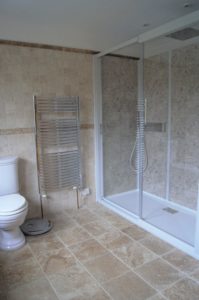 The Kocoon is a cubicle with a difference. With all the benefits of Kinedo self-contained shower cubicles, the Kocoon differs with its luxury shower panels, rather than the glass internal panels that Kinedo cubicles are famous for.
The Kocoon is a cubicle with a difference. With all the benefits of Kinedo self-contained shower cubicles, the Kocoon differs with its luxury shower panels, rather than the glass internal panels that Kinedo cubicles are famous for.
The cubicles are available in multiple sizes and are popularly used as bath replacement products. One customer, from the Midlands, was looking for such a product that would blend into the original décor of his smartly tiled bathroom and the beige patterned shower wall of the Kocoon looked like a perfect match. However, the standard specification of a recessed Kocoon – with two patterned end panels and a single plain back panel – didn’t meet his unique requirements.
The customer not only wanted all three panels with the pattern, but also an alternative installation point for the shower valve and showerhead. Unable to support the request, the
local plumbers merchant recommended direct contact with the Kinedo technical team, who provided personalized support for a personalized shower cubicle.
After colour samples were sent to the customer for approval, the team ordered a set of bespoke panels from the company’s manufacturing base in France and no holes were pre-drilled to enable a bespoke shower valve installation on site.
The unit was delivered and installed within 9 weeks of the initial enquiry and the customer is delighted with the result;
“From start to finish the team to Kinedo have bent over backwards to support my requirements. I am really pleased with the cubicle which slots directly into the recess where my bath was previously. I was keen to retain the existing tiles and this cubicle gave me that opportunity. Then, when I wanted something over and above the standard spec, the team could not have been more helpful and I think the result is absolutely stunning.”
The Kocoon cubicle is supplied as one integrated package that includes the tray, internal shower panels, glass external panels and door, as well as the smart shower valve, rainshower head and handheld shower with anti-twist hose.
The specification team at Kinedo is very happy to work with installers and specifiers to deliver solutions, including sales specials, that meet any project requirements. The technical team will also deliver installation training on-site to ensure that all plumbers and installers can benefit from best practice installation. A Kinedo cubicle can be installed and ready to use in under half a day. With no tiles, grout or silicone required it really is an efficient solution.
View Kinedo's profile:
Learn how Saint-Gobain PAM products help to ensure your construction project achieves its sustainable targets
Story
With a New Year comes an increasing focus on Sustainability and PAM are doing everything possible to ensure their products play their part in helping ensure your construction project achieves its sustainable targets in terms of recyclability, carbon reduction, reduced waste, reduced time spent on the install… The list goes on. Why not watch the video to learn more!
View PAM Building's profile:
Saniflo parent company SFA Group wins social responsibility award
Story
 SFA Group –Saniflo UK’s parent company – has been awarded a Bronze Medal for Corporate Social Responsibility from EcoVadis, the world’s most trusted provider of business sustainability ratings. This result places the SFA Group among the top 50% of companies assessed by EcoVadis.
SFA Group –Saniflo UK’s parent company – has been awarded a Bronze Medal for Corporate Social Responsibility from EcoVadis, the world’s most trusted provider of business sustainability ratings. This result places the SFA Group among the top 50% of companies assessed by EcoVadis.
The EcoVadis assessment is built on international sustainability standards, including the Global Reporting Initiative, the United Nations Global Compact, and the ISO 26000, covering 200 spend categories and 160+ countries.
SFA Group was rated based on a sustainability scorecard which illustrates performance across 21 indicators in four main categories of environment, labour and human rights, ethics, and sustainable procurement.
Saniflo UK Head of Marketing and Product Management, Ann Boardman, says: “At Sanifo UK we uphold the same high standards set by our parent company, SFA Group in France. We pride ourselves on our ongoing commitment to being the best we can be in all ways, always. This Bronze medal is well deserved.”
View Saniflo's profile:
See how to use Saint-Gobain PAM’s Ensign range pre-assembled stack assemblies in Revit with this new tutorial
Story
Saint-Gobain PAM aims to ease the burden on developers, specifiers and contractors in the early stages of construction by providing two levels of BIM library and supporting elements in Revit for our Ensign Range. These files will make it easier for early stage specification in BIM and will speed up the whole planning process; this in turn will create measurable cost and time savings for our customers.
Watch the tutorial to see how to use the pre-assembled stack assemblies in Revit.
View PAM Building's profile:
Crittall ‘Sustainability’ focussed Podcast Series – Edition 4 – Transcript to support learning
Story
Steel Windows – Sustainability meets Style – Edition 4 – ‘The sustainability plusses emphasised by Steel Windows’
Crittall ‘Sustainability’ focussed Podcast Series – Edition 4 – Transcript to support learning
‘Nobody can doubt the strength of steel as a construction material, but its qualities in the field of sustainability are rather less obvious, but no less impressive’ says Russell Ager, Managing Director of Crittall Windows.
And in this special edition series of bite-sized learning podcasts sponsored by Crittall, we discuss The Strength of Steel, The Life Cycle Assessment of Steel, How to protect Steel Building Materials from corrosion and why Windows are one particular building component that emphasises the plusses of sustainability for the material.
In this fourth edition we discuss ‘The sustainability plusses emphasised by Steel Windows’
So, one particular steel building component that emphasises the sustainability plusses of the material are windows. Manufactured under controlled conditions to reap the benefits already enumerated for steel as a material,
Crittall Windows operates within the constraints of ISO 14001:2004; a recognised international environmental management standard that sets targets for solids, liquids, gaseous emissions and waste generation.
But the finished product itself, which is galvanized for enhanced longevity, offers other benefits because of the nature of the material. Because of their inherent strength steel windows have much thinner frames than is possible with other window materials. This lets in more daylight thus reducing the use of artificial lighting in the buildings in which they are installed. Taken over the elevations of a large commercial building this could lead to impressive savings in both energy usage and cost.
Supreme strength and matchless elegance are unusual partners, but they sit side by side in the world’s most recyclable building material. And who said sustainability and good looks could not go hand in hand.
Thank you for listening to the fourth and final edition of this bite-sized learning podcast series. Make sure you listen to all 4 editions to fully understand how with Steel Windows – Sustainability meets Style!
For more information about Crittall steel windows, please go to www.crittall-windows.co.uk
View Crittall's profile:
Crittall ‘Sustainability’ focussed Podcast Series – Edition 3 – Transcript to support learning
Story
Steel Windows – Sustainability meets Style – Edition 3. ‘How Steel Building Materials are Protected from Corrosion’
Crittall ‘Sustainability’ focussed Podcast Series – Edition 3 – Transcript to support learning
‘Nobody can doubt the strength of steel as a construction material, but its qualities in the field of sustainability are rather less obvious, but no less impressive’ says Russell Ager, Managing Director of Crittall Windows.
And in this special edition series of bite-sized learning podcasts sponsored by Crittall, we discuss The Strength of Steel, The Life Cycle Assessment of Steel, How to protect Steel Building Materials from corrosion and why Windows are one particular building component that emphasises the plusses of sustainability for the material.
In this third edition we discuss ‘How Steel Building Materials are Protected from Corrosion’
A key element in the use of steel as a building material is galvanizing providing protection against corrosion. In this process the steel is coated with zinc to prevent it from rusting. The cleaned steel is dipped into molten zinc at around 450 degrees C and a series of zinc-iron alloy layers are built up by a metallurgical reaction between the iron and zinc creating a strong bond between steel and the coating.
The galvanizing process is energy efficient taken as part of a whole life cycle which is the only meaningful way of calculating the impact on such a long-lasting material. It prolongs the life of an already long-life product, and it does not affect recyclability or re-use. Galvanized steel can be thrown into the scrap furnace and steel can easily be re-galvanized.
Thank you for listening to the third edition of this bite-sized learning podcast series. Make sure you listen to all 4 editions to fully understand how with Steel Windows – Sustainability meets Style!
In the next edition we discuss ”The sustainability plusses emphasised by Steel Windows’
For more information about Crittall steel windows, please go to www.crittall-windows.co.uk
View Crittall's profile:
Crittall ‘Sustainability’ focussed Podcast Series – Edition 2 – Transcript to support learning
Story
Steel Windows – Sustainability meets Style – Edition 2. ‘The Life Cycle Assessment of Steel’
Crittall ‘Sustainability’ focussed Podcast Series – Edition 2 – Transcript to support learning
‘Nobody can doubt the strength of steel as a construction material, but its qualities in the field of sustainability are rather less obvious, but no less impressive’ says Russell Ager, Managing Director of Crittall Windows.
And in this special edition series of bite-sized learning podcasts sponsored by Crittall, we discuss The Strength of Steel, The Life Cycle Assessment of Steel, How to protect Steel Building Materials from corrosion and why Windows are one particular building component that emphasises the plusses of sustainability for the material.
In this second edition we explore ‘The Life Cycle Assessment of Steel’
Produced using iron, the most abundant element on the planet, steel manufacturing impact is calculated by the World Steel Association using what
is called the ‘system expansion’ method of life cycle assessment. This looks at steel to be part of a global system of supply and demand and takes account of co-products used in the manufacturing processes that save energy or reduce emissions. One example is waste gases from the process being re-used to generate electricity for the process.
The full life calculation, which also takes account of steel’s high strength-to-weight ratio (meaning less achieves more) means that overall CO2 emissions associated with a steel building – from component manufacture through its life in use – will be lower than for other materials.
Moving away from the mathematics the nature of steel and its construction also augments its sustainability tally. All the fabrication process, the testing and the certification takes place in a controlled and monitored factory environment. This ensures adherence to consistently high standards and quality. This in turn leads to quicker, safer and more predictable outcomes on-site. Construction processes can therefore be more efficient, not to mention more cost-effective.
Thank you for listening to the second edition of this bite-sized learning podcast series. Make sure you listen to all 4 editions to fully understand how with Steel Windows – Sustainability meets Style!
In the next edition we discuss ‘How Steel Building Materials are Protected from Corrosion’
For more information about Crittall steel windows, please go to www.crittall-windows.co.uk





